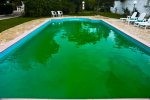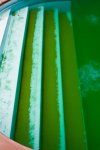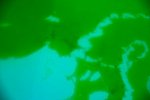Hi All
I came accross this site whilst searching in desperation for information.
I live in Southern Italy, near Brindisi.
I'm retired and to fill in the long hours of wall to wall sunshine, I started looking after a few swimming pools.
I devoured every piece of information, bought the biggest pool robot and electronic water testing equipment and now have a fantastic time cleaning and maintaining 7 pools.
6 of them are fantastic and I have to say that I love the accolades from guests saying how nice it is to have such a well maintained pool.
OK, my problem.
One pool is just about impossible to keep clean.
It is situated in a well maintained garden, surrounded by a 3m wall.
3 weeks ago I had a call to say that the pool was turning green. I had only cleaned it the day before.
On arrival, the pool was not turning green, IT WAS DARK GREEN. (I'll attach a few piccies at the end of this saga)
This was the fifth time this year this has happened to this pool.
This was the worst and the quickest. In 24 hours it had gone from clear sparkling clear water, to thick slimy pea soup.
All chemical levels are OK.
I spent a week getting it back into shape and ended up with clear sparkling water again.
Today, we have guests arriving from Norway, so yesterday, I spent 3 hours cleaning, scrubbing and preparing what was already a pretty clean pool.
I finished at 2pm, I returned at 4pm, just two hours later and could see the bottom of the pool already starting to be covered in green algae.
This morning, I returned to clean it again before the guests arrived and the whole bottom was covered. Fortunately, it had not started to turn the water green yet and so I was able to clear it out very gently without it clouding up.
I have taken samples of the water and had it analysed in a local water laboratory, who have confirmed that the green is of a vegetable origin.
They have also told me that this algae is actually eating the chlorine and thriving on it.
OK, so now for my question.
1 . Can algae be introduced to the water from surrounding vegetation. :?:
2 . Would it be possible to actually add algae in whatever form to a swimming pool. :?:
3 . If, this is some weird naturally reacurring problem that is so virulent that it can cover a 12m x 6m x 3m, deep pool, in hours, how can I kill it. :?:
Below, a few piccies of the pool at its worst.
Thanks for reading this, sorry its a bit long, but I thought that a bit of background information might be of help.
Best wishes from SUNNY Puglia, Italy.
Gerry
[attachment=2:i3mnuy0z]Keith-Swimming-pool.jpg[/attachment:i3mnuy0z]
[attachment=0:i3mnuy0z]Keith-Swimming-pool-3.jpg[/attachment:i3mnuy0z]
[attachment=0:i3mnuy0z]Keith-Swimming-pool-3.jpg[/attachment:i3mnuy0z]
I came accross this site whilst searching in desperation for information.
I live in Southern Italy, near Brindisi.
I'm retired and to fill in the long hours of wall to wall sunshine, I started looking after a few swimming pools.
I devoured every piece of information, bought the biggest pool robot and electronic water testing equipment and now have a fantastic time cleaning and maintaining 7 pools.
6 of them are fantastic and I have to say that I love the accolades from guests saying how nice it is to have such a well maintained pool.
OK, my problem.
One pool is just about impossible to keep clean.
It is situated in a well maintained garden, surrounded by a 3m wall.
3 weeks ago I had a call to say that the pool was turning green. I had only cleaned it the day before.
On arrival, the pool was not turning green, IT WAS DARK GREEN. (I'll attach a few piccies at the end of this saga)
This was the fifth time this year this has happened to this pool.
This was the worst and the quickest. In 24 hours it had gone from clear sparkling clear water, to thick slimy pea soup.
All chemical levels are OK.
I spent a week getting it back into shape and ended up with clear sparkling water again.
Today, we have guests arriving from Norway, so yesterday, I spent 3 hours cleaning, scrubbing and preparing what was already a pretty clean pool.
I finished at 2pm, I returned at 4pm, just two hours later and could see the bottom of the pool already starting to be covered in green algae.
This morning, I returned to clean it again before the guests arrived and the whole bottom was covered. Fortunately, it had not started to turn the water green yet and so I was able to clear it out very gently without it clouding up.
I have taken samples of the water and had it analysed in a local water laboratory, who have confirmed that the green is of a vegetable origin.
They have also told me that this algae is actually eating the chlorine and thriving on it.
OK, so now for my question.
1 . Can algae be introduced to the water from surrounding vegetation. :?:
2 . Would it be possible to actually add algae in whatever form to a swimming pool. :?:
3 . If, this is some weird naturally reacurring problem that is so virulent that it can cover a 12m x 6m x 3m, deep pool, in hours, how can I kill it. :?:
Below, a few piccies of the pool at its worst.
Thanks for reading this, sorry its a bit long, but I thought that a bit of background information might be of help.
Best wishes from SUNNY Puglia, Italy.
Gerry
[attachment=2:i3mnuy0z]Keith-Swimming-pool.jpg[/attachment:i3mnuy0z]
[attachment=0:i3mnuy0z]Keith-Swimming-pool-3.jpg[/attachment:i3mnuy0z]
[attachment=0:i3mnuy0z]Keith-Swimming-pool-3.jpg[/attachment:i3mnuy0z]





 What are you using for chlorination?
What are you using for chlorination?